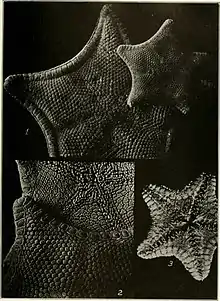Ceramaster arcticus
Ceramaster arcticus, the Arctic cookie star, is a species of sea star. It is pink and often has dark red accents. It has broad arms, no spines, and no pincers, or pedicellariae. It is considered rare and only inhabits the Pacific Ocean off the coast of northwestern North America.[3]
| Ceramaster arcticus | |
|---|---|
 | |
| Ceramaster arcticus (1 and 2) and Pseudarchaster parelii alascensis (3) | |
| Scientific classification | |
| Kingdom: | |
| Phylum: | |
| Class: | |
| Order: | |
| Family: | |
| Genus: | |
| Species: | C. arcticus |
| Binomial name | |
| Ceramaster arcticus | |
Description
A member of the sea star genus Ceramaster (often referred to as cushion stars), the Arctic cookie star is broadly pentagonal, rigid, and like other Ceramaster species, has no arms. The species' aboral surface (i.e., the top of the sea star) has small flat-topped plates. Growing up to 11 cm across (4.2 inches), it is pink and often has red accents. The species preys on sponges.[3]
The species is similar to the more common cookie star (Ceramaster patagonicus).
Distribution
The species inhabits the Pacific Ocean off the northwestern coast (intertidal zone) to a depth of 186 meters (610 feet)) of North America, ranging from the Aleutian Islands to the north to the Strait of Juan de Fuca to the south. While rare, according to Sea Stars of the Pacific Northwest, the species is more abundant in the northern portion of its range.[3]
References
- "NATIONAL ACADEMY OF SCIENCES OF THE UNITED STATES OF AMERICA : BIOGRAPHICAL MEMOIR OF ADDISON EMERY VERRILL 1839-1926 BY WESLEY R. COE" (PDF). Nasonline.org. Retrieved 31 March 2022.
- "Encyclopedia of Life". Eol.org. Retrieved 31 March 2022.
- "Family Goniasteridae : ARCTIC COOKIE STAR (Ceramaster arcticus)". Archived from the original on 9 September 2012. Retrieved 31 March 2022.